A Complete Guide On How To Potty Train Your Toddler
Potty training… It’s something all first-time parents fear and simultaneously they can’t wait for it to be over. Potty training is a light at the end of the tunnel – a tunnel filled with dirty diapers and toilet accidents.
As with every element of parenting, there are millions of different opinions on potty training and how best to do it. It can be overwhelming and, honestly, who wants to spend days reading about the best potty training methods.
This is why we have put together this guide. It is full of tried and tested, pragmatic tips that will make potty training your toddler easier. We will also briefly touch on the 4 main schools of potty training to help you understand what you are doing and why.
And if you love this guide on how to potty train your toddler, make sure you check out these guides on potty training at night time, what to do with extra diapers, and best overnight diapers. Or even our guide on the best pull-ups for older bedwetters.

The Types Of Potty Training Methods
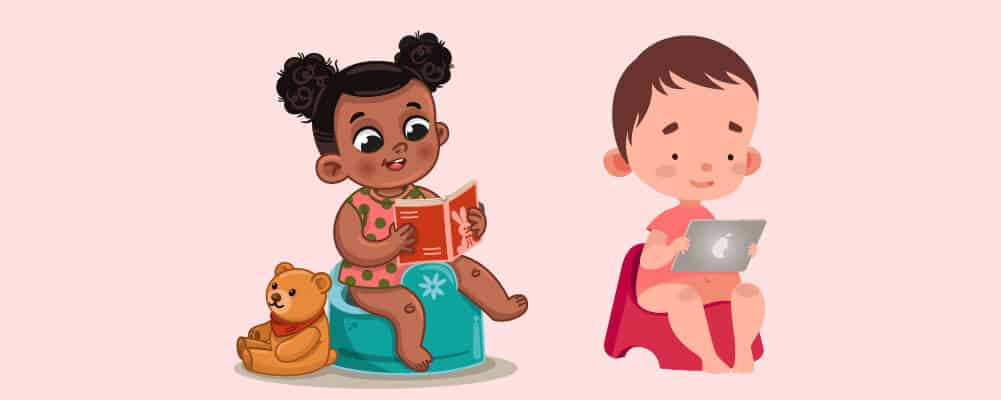
Let’s start with the potty training basics and look at the types of potty training methods that you can use.
If you are new to the world of potty training then you probably read the above sentence and thought, why do I need to follow a potty training method? Well, you don’t. However, the following four methods have been tried, tested, and have been proved to work.
Why would you start from the very beginning and work everything out yourself when someone has already done a lot of the hard work for you? Exactly!
Every child is different and what works for one child might not work for another (even between siblings) and you may find that you need to use a combination of these methods to teach your child to use the potty.
We recommend treating these theories as guides that can be tweaked to suit your child and their unique needs.
Brazelton Child-Oriented Potty Training
This technique is supported by the American Academy of Pediatrics. It is an intuitive way of teaching your child to use the potty, that involves letting them and their curiosity lead the way.
With this method, you will introduce your child to the potty and talk to them about what it is and when it can be used.
Then, when they show signs of needing to use the toilet, you can ask them if they want to use the potty. When they do, lead them to the potty, allow them to use it, and afterward you can praise them.
The most important element of this type of potty training is that you never force the child to use the potty or shame them for not using it. It is all positive reinforcement and is led by their own curiosity.
Infant Potty Training
This method is not one that is recommended by many pediatricians, but many people swear that it worked for them and their children.
This method involves getting your child to use the potty from the age of one month. Whenever you see the signs of your child needing the toilet, you take them to the bathroom and help them use the potty.
The idea is not to use diapers after the first month of your baby’s life. However, this can be very messy and stressful. It involves watching your baby in the night while they sleep and will not work well if your baby is in daycare.
Parent-Led Potty Training
If you have a baby that has multiple caregivers – for example, they are in daycare or staying with a grandparent while you work – then this is a great method.
This method involves the parent choosing when the child sits on the potty. They take note of when their child typically goes to the bathroom and then build a potty routine around that.
This method allows for consistency of routine no matter who the child is with. Which in turn will make it easier for the child to learn how to use the potty.
This is a routine that nervous children can find very helpful, as they don’t have to ask to use the bathroom.
3-Day Potty Training
You won’t be surprised to hear that the 3-Day Potty Training method involves a solid 3 days of potty training. This method involves you removing the diapers for three days and following your little one around, taking them to the potty whenever they need to go.
Of the four methods we have talked about, this is the most intense method. It has the possibility of being the messiest and the most frustrating. And you might find that after three days you don’t have a potty-trained toddler. However, this is a technique that has worked for many, many families.
To make this method work you are going to need three days at home with your little one. We recommend that you don’t do this alone, as you will be left very tired and stressed. Instead, you should enlist a partner, a parent, or a friend to help you.
Let your little one go diaper-free for the 3 days. Then, when they are ready to go to the toilet, take them over to the potty and let them use it. They will soon learn that this is what you want them to do when they need to go to the toilet.
There is a high possibility that you will arrive at the potty too late a few times. So have some cleaning equipment and spare clothes for everyone on hand.
Signs Your Toddler Is Ready For Potty Training
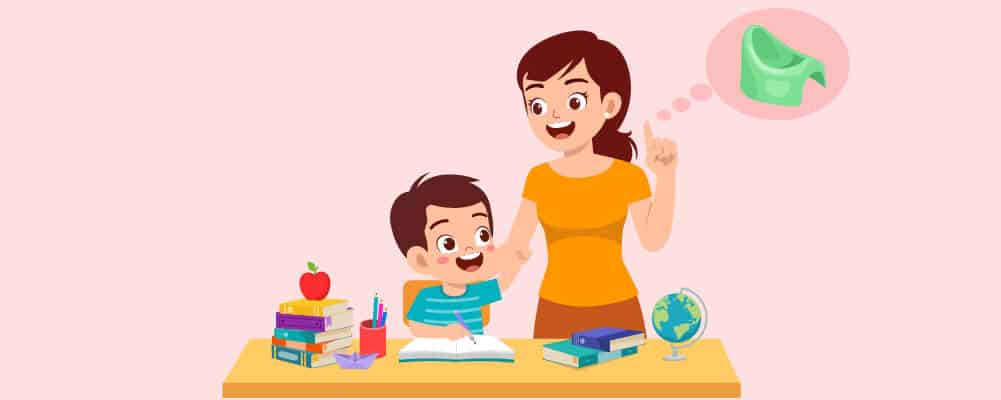
One of the big questions when it comes to potty training is – when do you start potty training?
You probably know a couple or two who boast about how quickly they potty trained their little one. This is actually not a good thing. It can make parenting feel like a competition and like the parents are trying to beat each other to the next big milestone.
However, parenting is not about the parents. The only person who matters in this situation is the child. You should only start potty training when your child is ready. A child can’t “fall behind”, they’re learning at their own pace. And don’t worry, your child will let you know when they are ready.
Don’t worry about a specific age to start potty training, instead keep an eye out for any of the following signs.
Going longer between bathroom trips
As your child grows they will start to go for longer without using their diapers. Their brain is preparing them for a time when they will need to use the toilet less frequently.
They won’t change how much they are eating and drinking but they will produce less dirty diapers
This is usually the first sign that your little one is ready to start potty training.
Has an interest in keeping dry and clean
Another sign that your little one is ready for potty training is that they want to stay clean and dry.
This can manifest itself in many different ways.
For example, your toddler could be very reluctant to put a diaper back on after you have changed it. They may also suddenly start trying to escape their diapers.
You may also notice that they are a lot less happy to sit in a dirty diaper. They may start kicking up a fuss as soon as they have gone to the toilet or try to take the diaper off themselves.
Waking up from a dry nap
Your toddler may start going to the toilet less when they are awake, but they may also stop going to the toilet while they are down for a nap too. This is a sign that they are ready to start toilet training.
Adults go to the toilet less because when they were hunter-gatherers it was safer to have a designated safe space to go rather than to go whenever and get caught by a beast. Using toilets also vastly improves life expectancy.
Going to the toilet less is a sign that your toddler is growing up and will soon be ready to use the potty.
Hiding when they go to the bathroom
If your toddler starts to want some privacy when they go to the bathroom, this is another sign that they will soon be ready to start using the potty.
Again, this comes from our evolutionary need to find somewhere safe to use the toilet. Hunter-gatherers would have been vulnerable while going to the toilet, this is why we all feel the need to go to the toilet in private.
If your little one hides when they are using their diaper this could be a sign that it is time to start potty training. Potty training can also reduce the embarrassment they are feeling (but probably don’t understand).
Shows an interest when you’re going to the bathroom
Another clear sign that your toddler is ready to start potty training is if they start to follow you into the bathroom. They may also start to ask you a lot of questions about what the bathroom is for and what you do in there. You may even find them exploring in the bathroom on their own.
If you answer their questions and they are still interested in learning more about the bathroom and how to use it, this is a good time to start the potty training process.
Telling you they are about to go or have just gone in their diaper
Our final tip is to be aware of how they talk about their diapers. If your little one is constantly telling you that their diaper is wet or they tell you when they have just been to the toilet in their diaper – this is a good sign that they are ready to move onto the next stage.
A really good sign that they are ready to start potty training is when they tell you before they use their diaper. This means that they have developed enough awareness to attempt to use the potty, rather than just going whenever and wherever they please.
Potty Training Girls & Boys: What’s The Difference?
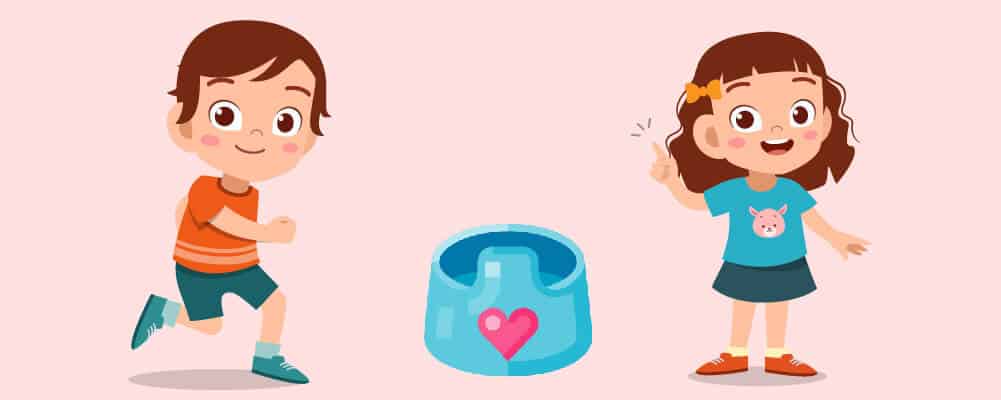
One of the questions that we get asked the most is – do boys or girls learn to use the potty faster?
The speed at which your baby will learn to use the potty will really depend on who they are as an individual rather than on their gender. However, there are some patterns that can be observed within the two genders.
Girls
Girls tend to show interest in potty training, as early as 17 months.
On the whole, girls tend to want to start potty training earlier than boys. They tend to develop faster than boys in general. Most parents also say that the process of potty training girls is easier than potty training boys. Although experiences vary depending on the individual child.
Dr. Heather Wittenberg believes that girls want to be potty trained earlier and learn the skill faster because they have more advanced movement and speaking skills as they reach 18 months. They tend to be more coordinated and are better at communicating what they want.
Girls tend to seek validation more than boys and they tend to be more concerned about what their parents think of them. A child that likes to be praised is much more likely to pick up skills quickly – potty training is no exception to this. If you have a boy who is interested in praise then they may also learn more quickly.
Boys
Boys usually take their time, boys aren’t always ready until they’re 2 years old.
In general, boys do things at their own pace and are happy to do so. They tend to have a lot less interest in what their parents think about them than girls do. This can make the whole potty training process a little more tricky.
If the child has no interest in doing the right thing or doing what they are told then you will have to be very careful about how you react to them. For example, lots of little boys get laughs when they do something they shouldn’t (like peeing where they shouldn’t) and this can make them think that they are on the right track. It is important to make it clear what is good behavior and what is not.
Boys can also be quite impatient when it comes to potty training, so it is important that you provide the calming influence as the parent.
Potty Supplies
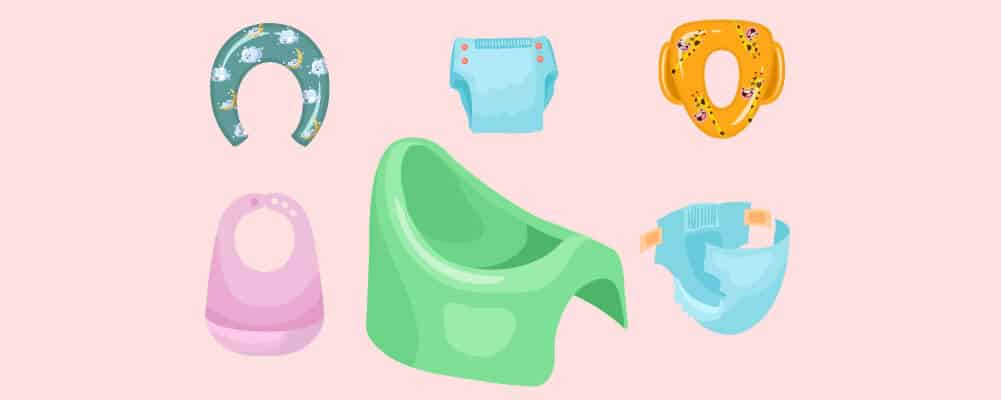
The phrase “failing to plan is planning to fail” is accurate in most of life’s situations, but it is incredibly apt when it comes to potty training. The more time you spend planning and preparing for this situation, the better.
Here are 3 items we recommend you have on hand when potty training your little one.
A potty seat
This may seem obvious, but getting the right type of potty seat for your child.
We wish it was the case, but training potties are not a one size fits all situation. This is partly because each child starts their potty training at a different age, so the size of potty they will need will vary.
You should also think about whether your child likes to sit still or to fidget. If they like to move around a lot then we recommend getting a potty that has a very wide base and is very hard to tip over.
Underwear / Pull Ups
Depending on the type of potty training you are doing, you might need to get your child used to wearing underwear or pull up diapers. While you are doing this (and for a little while after) it will be good to have a lot of spare pairs of underwear or pull ups on hand.
One of the most important reasons to carry spare underwear and pull ups with you is to prevent your child from getting embarrassed when they fail to make it to the potty. This can upset them and make them lose their confidence. Having a few spares on hand, even when you’re not at home, can help to keep their confidence high.
You may also like these guides on:
- Pampers Easy Ups vs Huggies Pull Ups
- Huggies Little Movers vs Pampers Cruisers
- Difference between diapers and pull ups
- Are pull ups as absorbent as diapers
- Is there a difference between boy and girl diapers?
Cleaning Supplies
No matter how many articles you read, how long you spend planning, and how capable your child is – there are going to be accidents and messes are going to be made.
Having cleaning supplies that are easy to reach can make each accident feel like less of a big deal and will also stop any permanent damage happening to your home.
Make sure that when you are cleaning the potty and the floor that you are using baby friendly fluids that won’t aggravate their skin.
How To Prepare Your Toddler For Potty Training
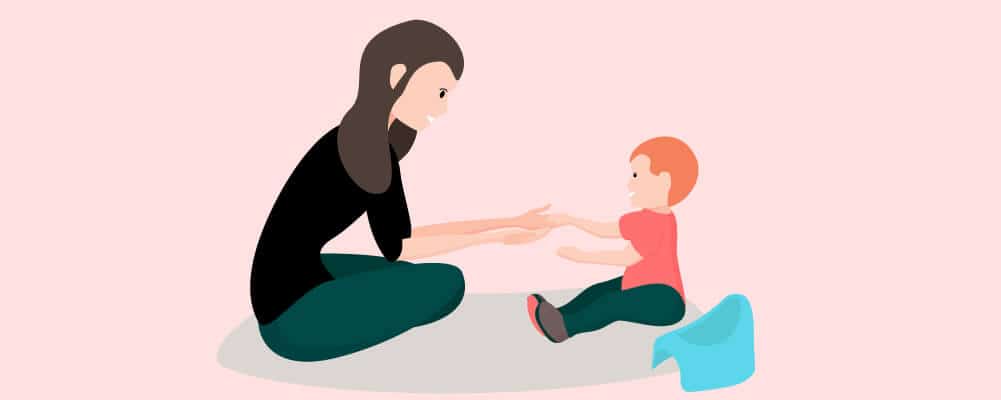
Now that you have prepared yourself and your home for potty training, it is time to prepare your toddler.
While doing this, try to remember what it is like to learn a new skill. Remember that it can be confusing without proper direction. So, think about how you can explain to your toddler what they are trying to learn and why.
Dress your toddler for potty training success
E.G. Pull up pants
The potty training season is not the time to dress your child up in complicated outfits – no matter how good they look.
You want to dress your toddler in a way that makes it easy for them to use the potty. They won’t have the dexterity to undo dungarees or to try and roll down tights. So, it is best to keep things as simple as possible for them.
Stick to pull up pants and shorter tops. Long tops are just a disaster waiting to happen (trust us!). The easier you can make the process for them the better.
Show your toddler how to use the potty
Toddlers learn by watching the adults around them. So, it is important that you show them how to use the potty, rather than just asking them to do it.
You can bring them into the bathroom with you and show them how you use the toilet. You can also sit with them while they use the potty and explain to them what is going on.
The more information that you can give them, the easier they will find the situation. They cannot do what you want them to do if they have no idea what that is.
Read about using the potty together
Speaking of passing on information. We live in the golden age of picture books – there truly is a book that is perfect for every situation. And there are plenty of books that you can read together at nap time that will talk your children through the wonders of using the potty.
With just a little research you will be able to find books about loads of their favorite characters using the potty.
How To Potty Train Your Toddler
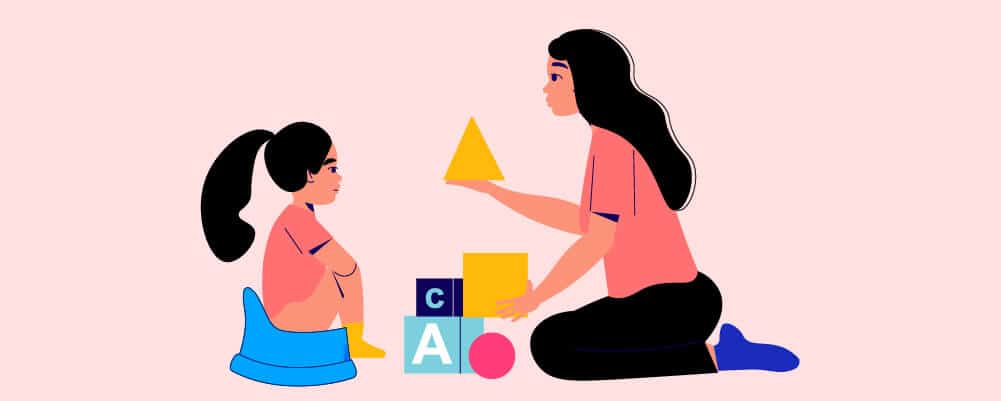
Now, it is time to get down to business.
We have prepared our homes for potty training. We have prepared our children (and their dresser) for potty training. And now it is time to start learning this new skill.
You’re probably wondering how long the whole process will take. The answer is, it will completely depend on your child. A confident, people-pleasing child picks up the skill very quickly. While a strong-willed little one may not be fussed by the prospect of learning something new.
You will need to work at your child’s speed and be patient with them. At this age, they are learning new things all the time – it’s exhausting! Let them take the process at their own pace and be there to support them when they need it.
Make sure your toddler is ready
Deciding when your child is ready to start potty training can feel difficult at first. But, you know your child well and it will become very clear when they are ready to start potty training.
Earlier we talked you through a list of things that your child will do to tell you that they are ready to start potty training. Here is the list again, just in case you need it:
- Going longer between bathroom trips
- Developing an interest in keeping clean and dry
- Waking up from a dry nap
- Hiding when they go to the bathroom
- Showing interest in what you are doing when you go to the bathroom
- Telling you that they have just been to the bathroom or that they are about to go to the bathroom
- Trying to take off their own diapers
If your child is showing any of the signs mentioned above then they might be ready to start potty training.
You shouldn’t rush your child into the process, you should wait until they are ready to start.
When they are ready to start you should talk to them about the process as much as you can. You can read books together about potty training, they can come into the bathroom with you, and you can talk them through the process. If they have any questions try to answer them as well as you can or go looking for answers together.
Once you are happy that your child is ready, it is time to set up the potty.
Place the potty in a convincing spot
When you are choosing where to set up the potty, it is important that you take some time to consider the right place.
One of the best things you can do for your child when you are potty training them is to keep the potty in the same place. That way they can learn where the potty is easy and they will associate that room with going to the bathroom.
Moving the potty around can complicate the process.
You want to make sure that it is a place where you and your child can easily access it. You want to make sure that you set it up in an area that is easy to clean. You should also make sure it is an area where your little one can go in on their own and not be in danger.
If you want to set your potty up in the kitchen or living room then you should be prepared for there to be a smell in these rooms. However, they are a great option because your child will spend a lot of time in these rooms and they will find the potty easy to get to.
Some people like to set their potties up in the bathroom to help their kids get in the habit of using the bathroom. They are easy rooms to clean and they are well ventilated so they won’t smell too bad. However, setting your potty up in the bathroom can be difficult if you don’t have a downstairs bathroom or one that is easy for your little one to use.
The right choice will really depend on the configuration of your house and the type of potty training you are carrying out.
Stick to a potty schedule
Consistency is important for young children, by the time you have reached the potty training stage you will be more than aware of this. However, it is extra important when you are trying to teach your child a new skill – like potty training.
There are three different situations that you should encourage your child to use the potty in:
- After they wake up from a nap or sleep
- After they have eaten
- Before they go down for a nap or sleep
You may also want to consider getting them to try using the potty before you leave the house. Although, this won’t be as consistent as eating or sleeping, so don’t worry if that doesn’t come naturally.
Before sleep
To get your little one used to sleeping without diapers, it is good to get them into the habit of using the potty before they sleep. This will help to reduce incidences of bedwetting.
After doing this multiple times, they will start to relate the action of using the toilet with being sleepy.
After a meal
Keep an eye on how long it takes your child to need the toilet after they have eaten. They start to encourage them to use the potty at around that time. Then, they will start to associate the feeling of needing to go to the bathroom with using the potty.
After sleep
You should also try to encourage your child to use the toilet after they have woken up. This will train their body to not evacuate while they are sleeping. If they have had a dry nap then they will most likely really need to use the potty.
Tips For Potty Training Success
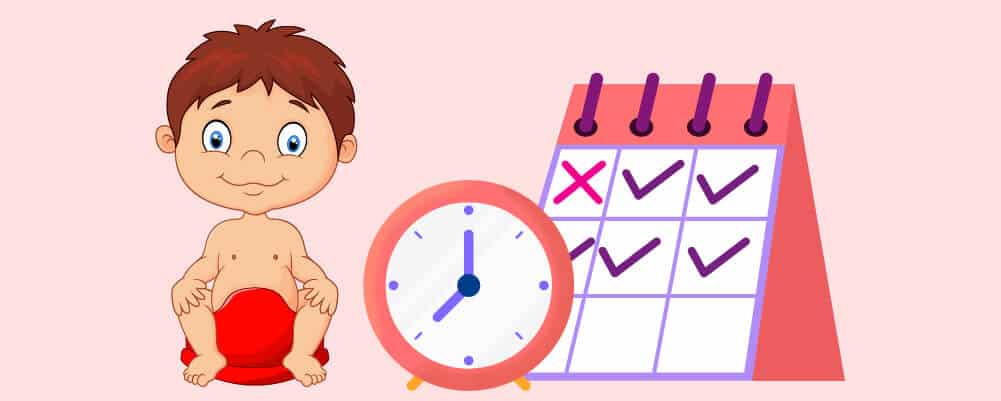
Before we go, we want to leave you with two final tips that have made the potty training period easier for us in the past. These are two tips that we swear by.
Have your toddler sit on the potty 15-30 mins after meals
Firstly, we recommend taking careful notes on how long it takes your little one to need the toilet after they have eaten. This will give you a good idea of when to schedule their potty training.
We have found that somewhere between 15-30 minutes is a good benchmark for this. But the kind of food your child is eating and how much they drink will also affect this time frame.
Be patient
Finally, we want to remind you to be patient. Sometimes potty training can feel like a losing battle. And sometimes you can feel like you’re failing as a parent because the process is not going as smoothly as you’d like it to be.
Ignore that voice in your head. You will succeed at potty training your child and even if the process is long and messy that doesn’t mean you are a bad parent. Every child takes to potty training completely differently. The best thing you can do is remember the process is about your child and to listen to what they need.
Final Thoughts on Potty Training

Potty training can be a difficult process for any family but don’t worry, you will get through it (and it will be worth it!).
There are a lot of theories surrounding when children should be potty trained and how it should be done. The most important thing you can do as a parent is to look at this information and work out how to best apply it to your little one.
As long as you are listening to them and doing what is best for them you cannot go wrong.
And if you want to check out any more of our guides, we recommend checking out these guides on best waterproof crib mattress pad, what to do with old cloth diapers, diaper bag essentials for toddlers, and how to prevent diaper blowouts.
